Business Model Concept: Toyota Case Study and Future Implications
VerifiedAdded on 2020/03/01
|9
|2204
|34
Essay
AI Summary
This essay provides a detailed analysis of the business model concept, emphasizing its role as a framework for business operations. It explores the essential components, including e-business archetypes, activity systems, and cost/revenue architecture, highlighting their significance in creating value and driving innovation. The essay also addresses the importance of adaptability in response to technological advancements, competition, and data volume changes. Using the Toyota company as a case study, it demonstrates how businesses must evolve their models to accommodate change. The essay concludes by emphasizing the need for future business model research to consider the inevitability of change, solve static and dynamic issues, facilitate value creation, and ensure value distribution among stakeholders. Key concepts covered include value creation, e-business, activity systems, and the importance of adapting to change within a business context.
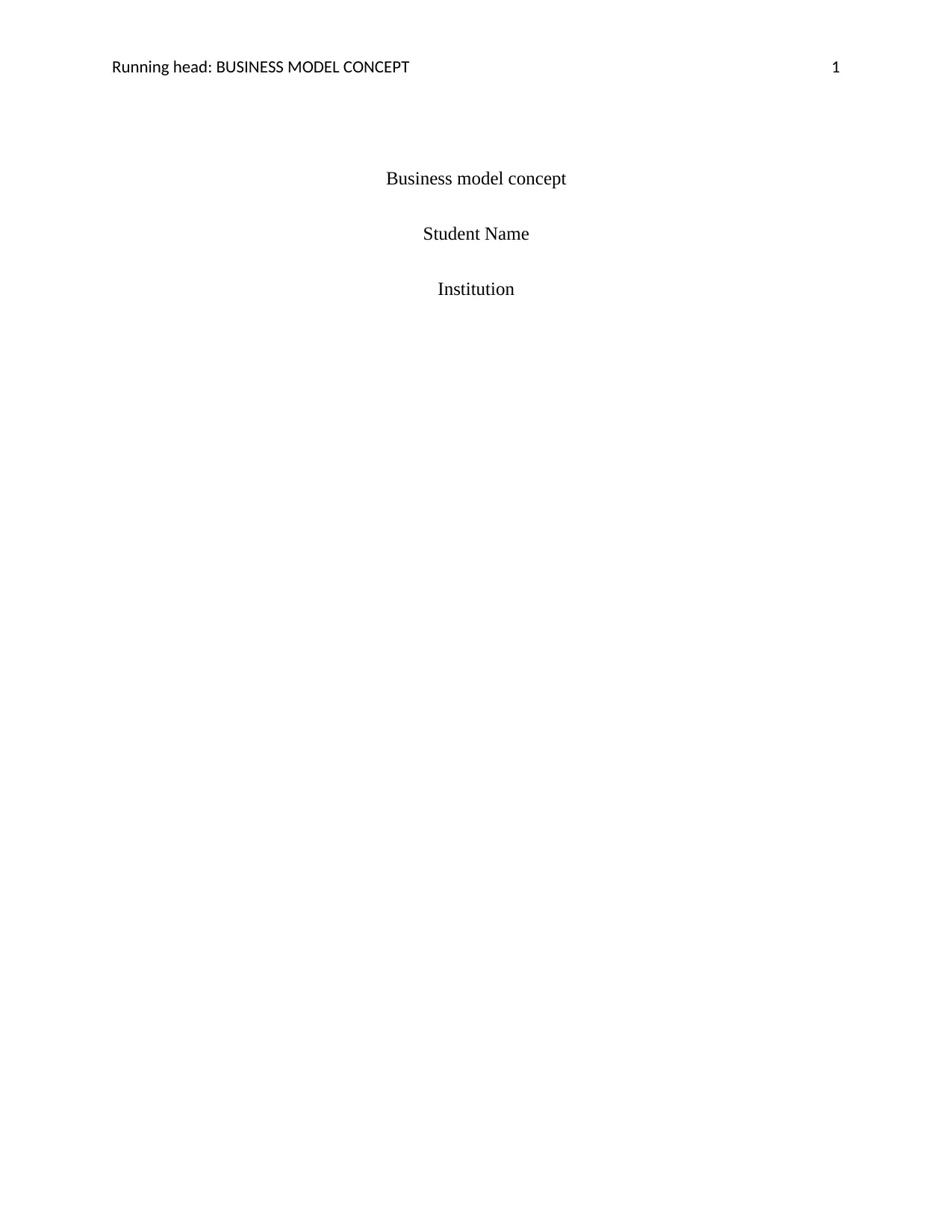
Running head: BUSINESS MODEL CONCEPT 1
Business model concept
Student Name
Institution
Business model concept
Student Name
Institution
Paraphrase This Document
Need a fresh take? Get an instant paraphrase of this document with our AI Paraphraser
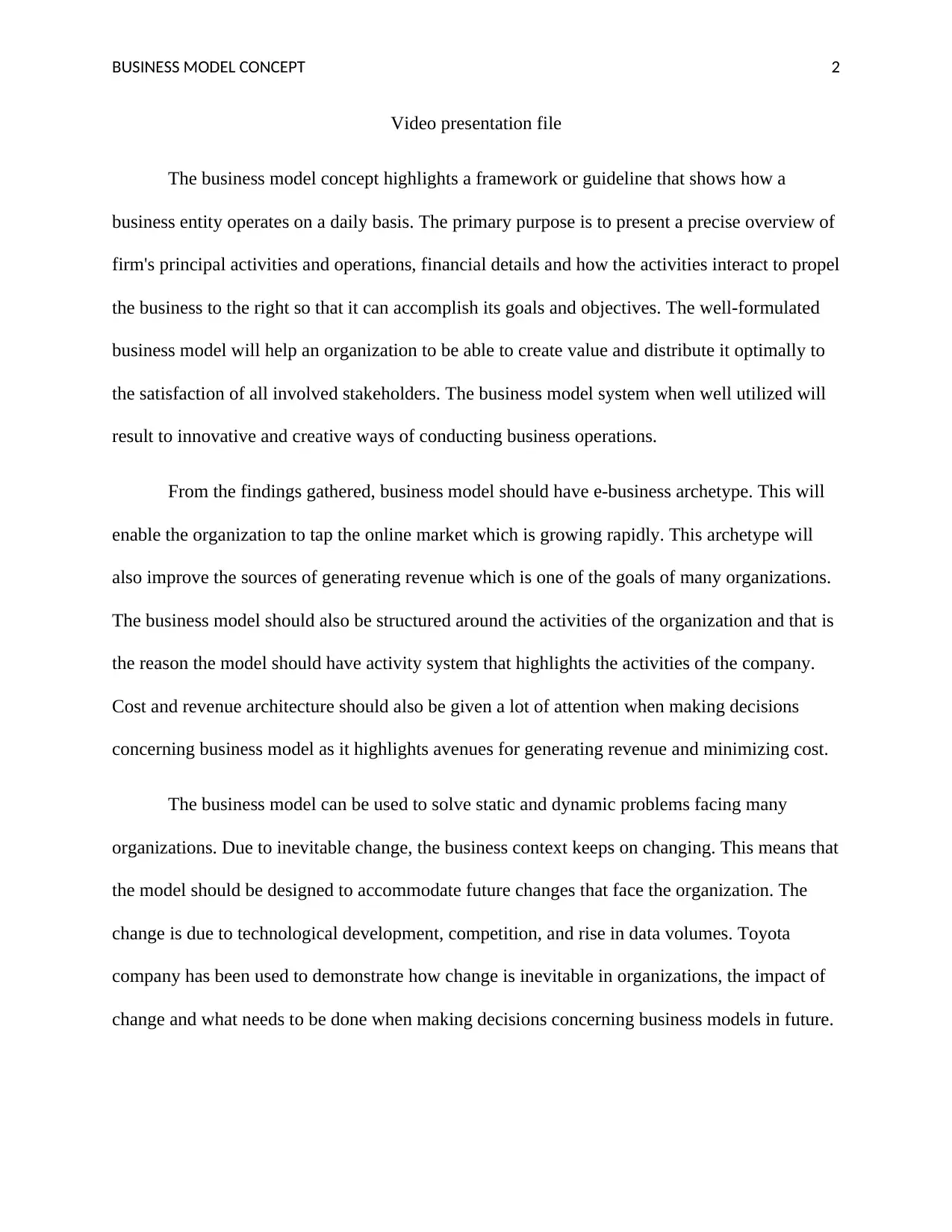
BUSINESS MODEL CONCEPT 2
Video presentation file
The business model concept highlights a framework or guideline that shows how a
business entity operates on a daily basis. The primary purpose is to present a precise overview of
firm's principal activities and operations, financial details and how the activities interact to propel
the business to the right so that it can accomplish its goals and objectives. The well-formulated
business model will help an organization to be able to create value and distribute it optimally to
the satisfaction of all involved stakeholders. The business model system when well utilized will
result to innovative and creative ways of conducting business operations.
From the findings gathered, business model should have e-business archetype. This will
enable the organization to tap the online market which is growing rapidly. This archetype will
also improve the sources of generating revenue which is one of the goals of many organizations.
The business model should also be structured around the activities of the organization and that is
the reason the model should have activity system that highlights the activities of the company.
Cost and revenue architecture should also be given a lot of attention when making decisions
concerning business model as it highlights avenues for generating revenue and minimizing cost.
The business model can be used to solve static and dynamic problems facing many
organizations. Due to inevitable change, the business context keeps on changing. This means that
the model should be designed to accommodate future changes that face the organization. The
change is due to technological development, competition, and rise in data volumes. Toyota
company has been used to demonstrate how change is inevitable in organizations, the impact of
change and what needs to be done when making decisions concerning business models in future.
Video presentation file
The business model concept highlights a framework or guideline that shows how a
business entity operates on a daily basis. The primary purpose is to present a precise overview of
firm's principal activities and operations, financial details and how the activities interact to propel
the business to the right so that it can accomplish its goals and objectives. The well-formulated
business model will help an organization to be able to create value and distribute it optimally to
the satisfaction of all involved stakeholders. The business model system when well utilized will
result to innovative and creative ways of conducting business operations.
From the findings gathered, business model should have e-business archetype. This will
enable the organization to tap the online market which is growing rapidly. This archetype will
also improve the sources of generating revenue which is one of the goals of many organizations.
The business model should also be structured around the activities of the organization and that is
the reason the model should have activity system that highlights the activities of the company.
Cost and revenue architecture should also be given a lot of attention when making decisions
concerning business model as it highlights avenues for generating revenue and minimizing cost.
The business model can be used to solve static and dynamic problems facing many
organizations. Due to inevitable change, the business context keeps on changing. This means that
the model should be designed to accommodate future changes that face the organization. The
change is due to technological development, competition, and rise in data volumes. Toyota
company has been used to demonstrate how change is inevitable in organizations, the impact of
change and what needs to be done when making decisions concerning business models in future.
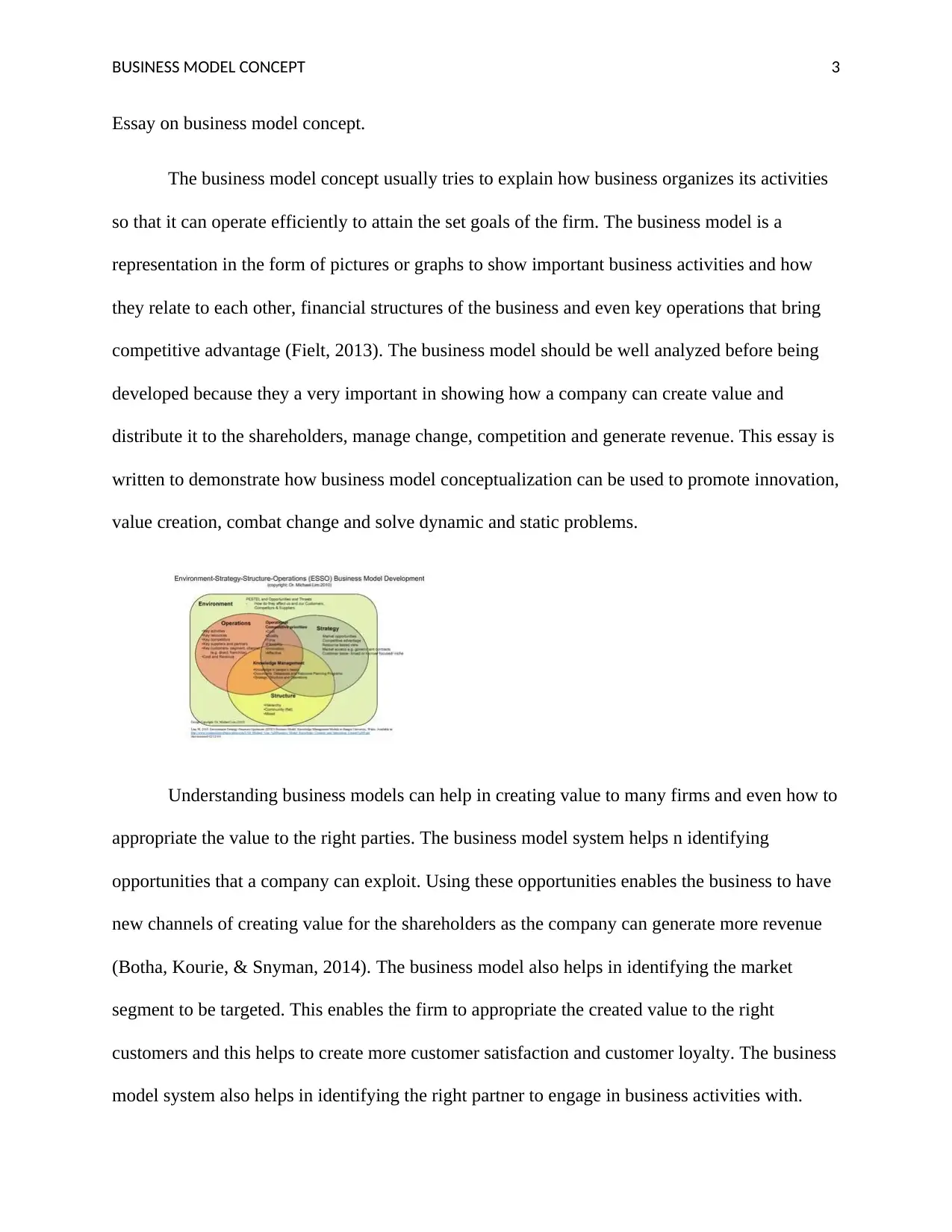
BUSINESS MODEL CONCEPT 3
Essay on business model concept.
The business model concept usually tries to explain how business organizes its activities
so that it can operate efficiently to attain the set goals of the firm. The business model is a
representation in the form of pictures or graphs to show important business activities and how
they relate to each other, financial structures of the business and even key operations that bring
competitive advantage (Fielt, 2013). The business model should be well analyzed before being
developed because they a very important in showing how a company can create value and
distribute it to the shareholders, manage change, competition and generate revenue. This essay is
written to demonstrate how business model conceptualization can be used to promote innovation,
value creation, combat change and solve dynamic and static problems.
Understanding business models can help in creating value to many firms and even how to
appropriate the value to the right parties. The business model system helps n identifying
opportunities that a company can exploit. Using these opportunities enables the business to have
new channels of creating value for the shareholders as the company can generate more revenue
(Botha, Kourie, & Snyman, 2014). The business model also helps in identifying the market
segment to be targeted. This enables the firm to appropriate the created value to the right
customers and this helps to create more customer satisfaction and customer loyalty. The business
model system also helps in identifying the right partner to engage in business activities with.
Essay on business model concept.
The business model concept usually tries to explain how business organizes its activities
so that it can operate efficiently to attain the set goals of the firm. The business model is a
representation in the form of pictures or graphs to show important business activities and how
they relate to each other, financial structures of the business and even key operations that bring
competitive advantage (Fielt, 2013). The business model should be well analyzed before being
developed because they a very important in showing how a company can create value and
distribute it to the shareholders, manage change, competition and generate revenue. This essay is
written to demonstrate how business model conceptualization can be used to promote innovation,
value creation, combat change and solve dynamic and static problems.
Understanding business models can help in creating value to many firms and even how to
appropriate the value to the right parties. The business model system helps n identifying
opportunities that a company can exploit. Using these opportunities enables the business to have
new channels of creating value for the shareholders as the company can generate more revenue
(Botha, Kourie, & Snyman, 2014). The business model also helps in identifying the market
segment to be targeted. This enables the firm to appropriate the created value to the right
customers and this helps to create more customer satisfaction and customer loyalty. The business
model system also helps in identifying the right partner to engage in business activities with.
⊘ This is a preview!⊘
Do you want full access?
Subscribe today to unlock all pages.

Trusted by 1+ million students worldwide
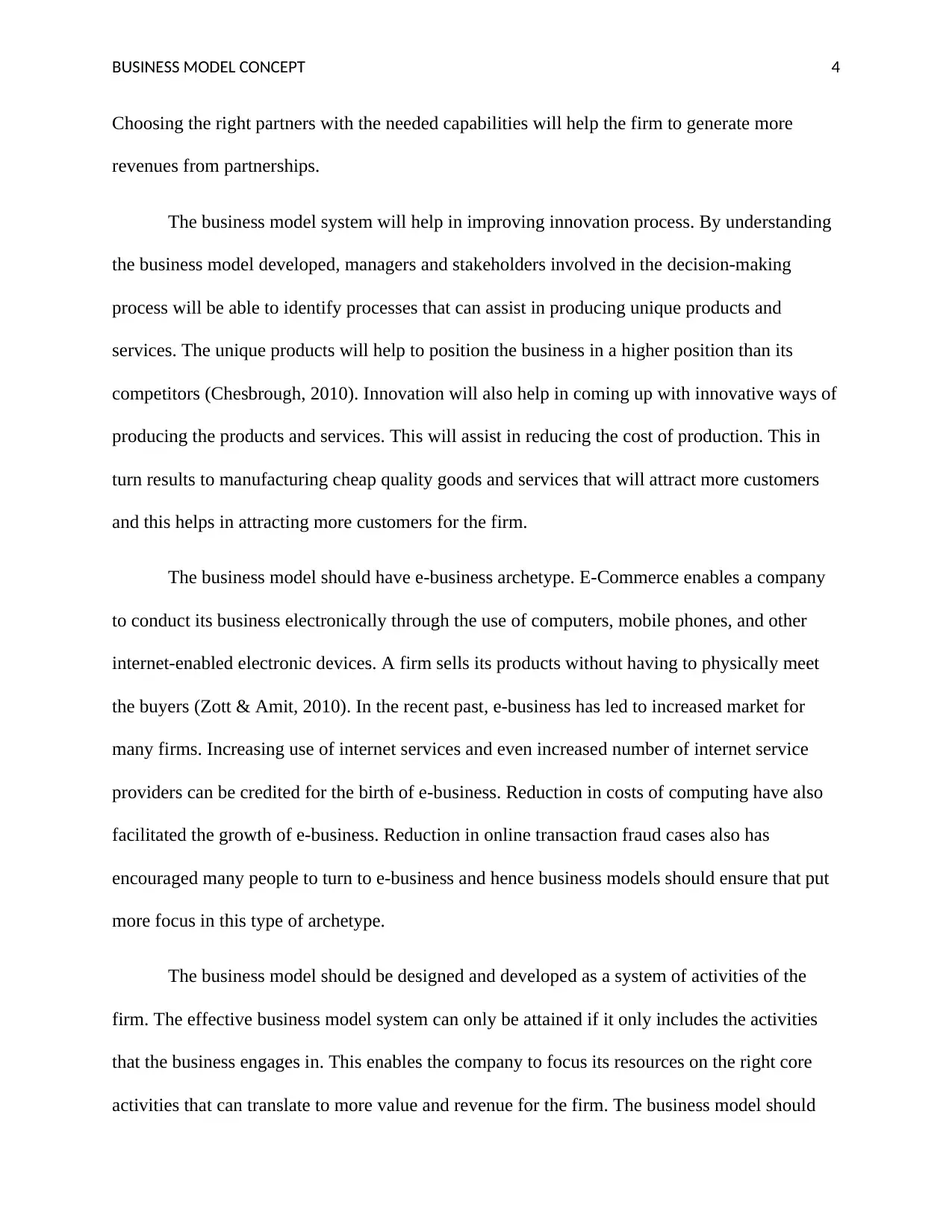
BUSINESS MODEL CONCEPT 4
Choosing the right partners with the needed capabilities will help the firm to generate more
revenues from partnerships.
The business model system will help in improving innovation process. By understanding
the business model developed, managers and stakeholders involved in the decision-making
process will be able to identify processes that can assist in producing unique products and
services. The unique products will help to position the business in a higher position than its
competitors (Chesbrough, 2010). Innovation will also help in coming up with innovative ways of
producing the products and services. This will assist in reducing the cost of production. This in
turn results to manufacturing cheap quality goods and services that will attract more customers
and this helps in attracting more customers for the firm.
The business model should have e-business archetype. E-Commerce enables a company
to conduct its business electronically through the use of computers, mobile phones, and other
internet-enabled electronic devices. A firm sells its products without having to physically meet
the buyers (Zott & Amit, 2010). In the recent past, e-business has led to increased market for
many firms. Increasing use of internet services and even increased number of internet service
providers can be credited for the birth of e-business. Reduction in costs of computing have also
facilitated the growth of e-business. Reduction in online transaction fraud cases also has
encouraged many people to turn to e-business and hence business models should ensure that put
more focus in this type of archetype.
The business model should be designed and developed as a system of activities of the
firm. The effective business model system can only be attained if it only includes the activities
that the business engages in. This enables the company to focus its resources on the right core
activities that can translate to more value and revenue for the firm. The business model should
Choosing the right partners with the needed capabilities will help the firm to generate more
revenues from partnerships.
The business model system will help in improving innovation process. By understanding
the business model developed, managers and stakeholders involved in the decision-making
process will be able to identify processes that can assist in producing unique products and
services. The unique products will help to position the business in a higher position than its
competitors (Chesbrough, 2010). Innovation will also help in coming up with innovative ways of
producing the products and services. This will assist in reducing the cost of production. This in
turn results to manufacturing cheap quality goods and services that will attract more customers
and this helps in attracting more customers for the firm.
The business model should have e-business archetype. E-Commerce enables a company
to conduct its business electronically through the use of computers, mobile phones, and other
internet-enabled electronic devices. A firm sells its products without having to physically meet
the buyers (Zott & Amit, 2010). In the recent past, e-business has led to increased market for
many firms. Increasing use of internet services and even increased number of internet service
providers can be credited for the birth of e-business. Reduction in costs of computing have also
facilitated the growth of e-business. Reduction in online transaction fraud cases also has
encouraged many people to turn to e-business and hence business models should ensure that put
more focus in this type of archetype.
The business model should be designed and developed as a system of activities of the
firm. The effective business model system can only be attained if it only includes the activities
that the business engages in. This enables the company to focus its resources on the right core
activities that can translate to more value and revenue for the firm. The business model should
Paraphrase This Document
Need a fresh take? Get an instant paraphrase of this document with our AI Paraphraser
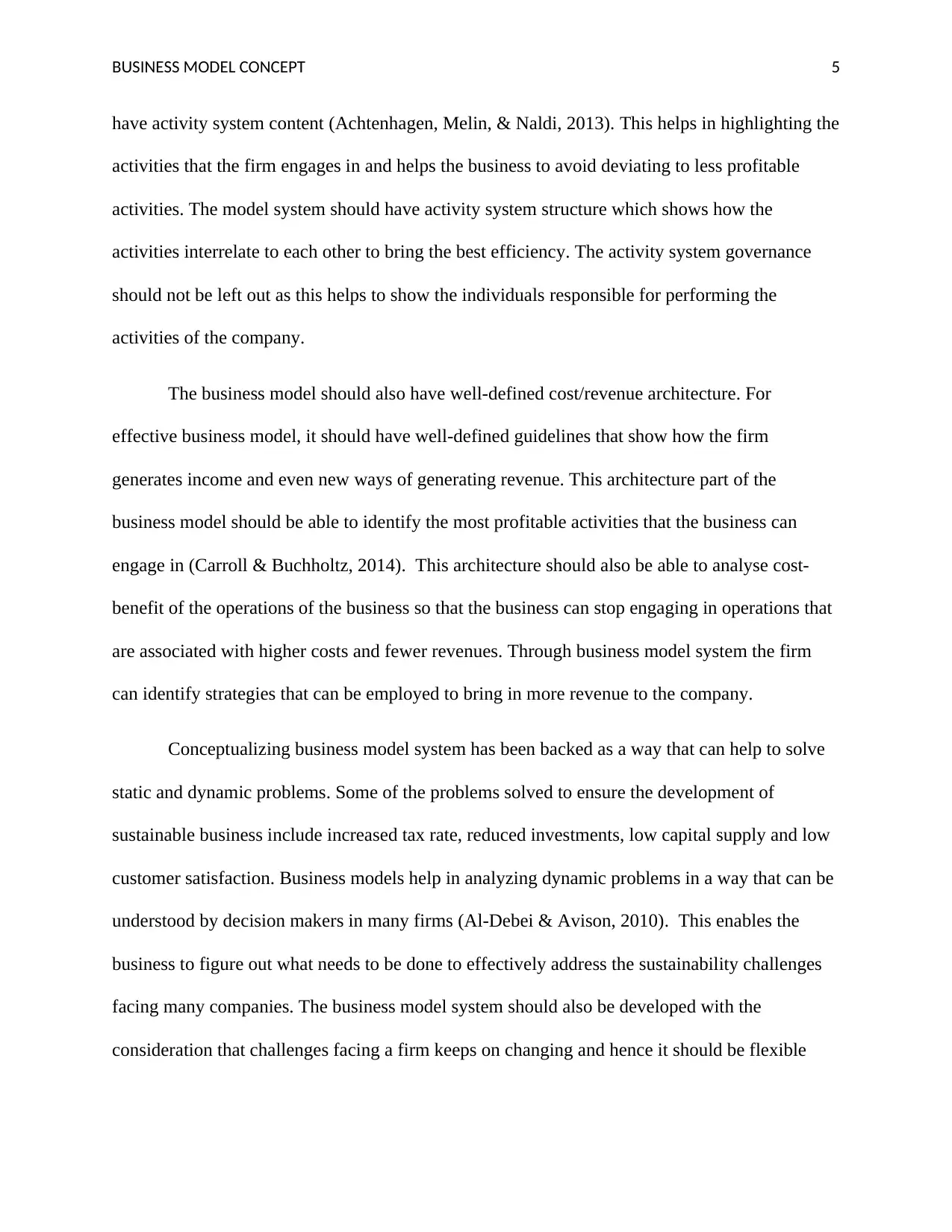
BUSINESS MODEL CONCEPT 5
have activity system content (Achtenhagen, Melin, & Naldi, 2013). This helps in highlighting the
activities that the firm engages in and helps the business to avoid deviating to less profitable
activities. The model system should have activity system structure which shows how the
activities interrelate to each other to bring the best efficiency. The activity system governance
should not be left out as this helps to show the individuals responsible for performing the
activities of the company.
The business model should also have well-defined cost/revenue architecture. For
effective business model, it should have well-defined guidelines that show how the firm
generates income and even new ways of generating revenue. This architecture part of the
business model should be able to identify the most profitable activities that the business can
engage in (Carroll & Buchholtz, 2014). This architecture should also be able to analyse cost-
benefit of the operations of the business so that the business can stop engaging in operations that
are associated with higher costs and fewer revenues. Through business model system the firm
can identify strategies that can be employed to bring in more revenue to the company.
Conceptualizing business model system has been backed as a way that can help to solve
static and dynamic problems. Some of the problems solved to ensure the development of
sustainable business include increased tax rate, reduced investments, low capital supply and low
customer satisfaction. Business models help in analyzing dynamic problems in a way that can be
understood by decision makers in many firms (Al-Debei & Avison, 2010). This enables the
business to figure out what needs to be done to effectively address the sustainability challenges
facing many companies. The business model system should also be developed with the
consideration that challenges facing a firm keeps on changing and hence it should be flexible
have activity system content (Achtenhagen, Melin, & Naldi, 2013). This helps in highlighting the
activities that the firm engages in and helps the business to avoid deviating to less profitable
activities. The model system should have activity system structure which shows how the
activities interrelate to each other to bring the best efficiency. The activity system governance
should not be left out as this helps to show the individuals responsible for performing the
activities of the company.
The business model should also have well-defined cost/revenue architecture. For
effective business model, it should have well-defined guidelines that show how the firm
generates income and even new ways of generating revenue. This architecture part of the
business model should be able to identify the most profitable activities that the business can
engage in (Carroll & Buchholtz, 2014). This architecture should also be able to analyse cost-
benefit of the operations of the business so that the business can stop engaging in operations that
are associated with higher costs and fewer revenues. Through business model system the firm
can identify strategies that can be employed to bring in more revenue to the company.
Conceptualizing business model system has been backed as a way that can help to solve
static and dynamic problems. Some of the problems solved to ensure the development of
sustainable business include increased tax rate, reduced investments, low capital supply and low
customer satisfaction. Business models help in analyzing dynamic problems in a way that can be
understood by decision makers in many firms (Al-Debei & Avison, 2010). This enables the
business to figure out what needs to be done to effectively address the sustainability challenges
facing many companies. The business model system should also be developed with the
consideration that challenges facing a firm keeps on changing and hence it should be flexible
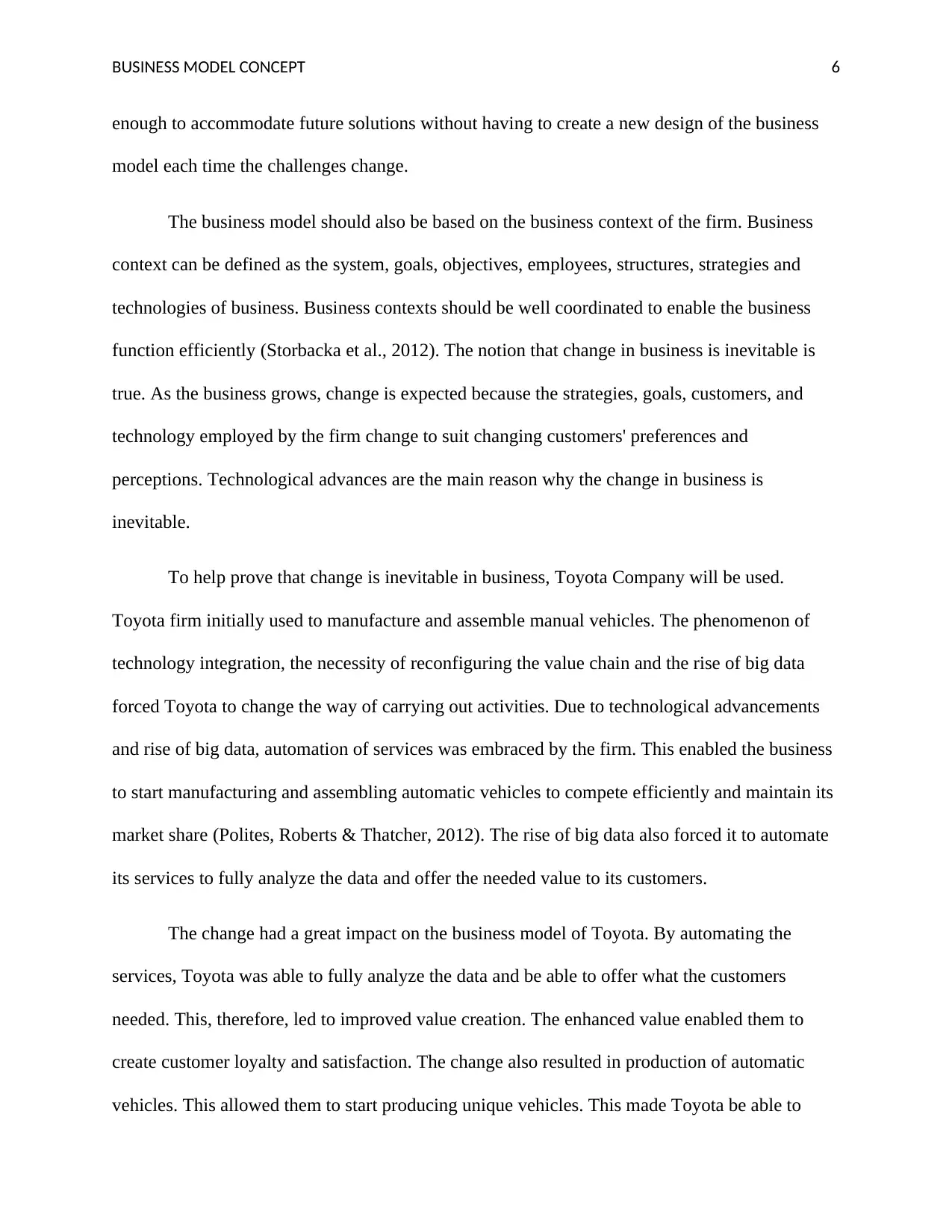
BUSINESS MODEL CONCEPT 6
enough to accommodate future solutions without having to create a new design of the business
model each time the challenges change.
The business model should also be based on the business context of the firm. Business
context can be defined as the system, goals, objectives, employees, structures, strategies and
technologies of business. Business contexts should be well coordinated to enable the business
function efficiently (Storbacka et al., 2012). The notion that change in business is inevitable is
true. As the business grows, change is expected because the strategies, goals, customers, and
technology employed by the firm change to suit changing customers' preferences and
perceptions. Technological advances are the main reason why the change in business is
inevitable.
To help prove that change is inevitable in business, Toyota Company will be used.
Toyota firm initially used to manufacture and assemble manual vehicles. The phenomenon of
technology integration, the necessity of reconfiguring the value chain and the rise of big data
forced Toyota to change the way of carrying out activities. Due to technological advancements
and rise of big data, automation of services was embraced by the firm. This enabled the business
to start manufacturing and assembling automatic vehicles to compete efficiently and maintain its
market share (Polites, Roberts & Thatcher, 2012). The rise of big data also forced it to automate
its services to fully analyze the data and offer the needed value to its customers.
The change had a great impact on the business model of Toyota. By automating the
services, Toyota was able to fully analyze the data and be able to offer what the customers
needed. This, therefore, led to improved value creation. The enhanced value enabled them to
create customer loyalty and satisfaction. The change also resulted in production of automatic
vehicles. This allowed them to start producing unique vehicles. This made Toyota be able to
enough to accommodate future solutions without having to create a new design of the business
model each time the challenges change.
The business model should also be based on the business context of the firm. Business
context can be defined as the system, goals, objectives, employees, structures, strategies and
technologies of business. Business contexts should be well coordinated to enable the business
function efficiently (Storbacka et al., 2012). The notion that change in business is inevitable is
true. As the business grows, change is expected because the strategies, goals, customers, and
technology employed by the firm change to suit changing customers' preferences and
perceptions. Technological advances are the main reason why the change in business is
inevitable.
To help prove that change is inevitable in business, Toyota Company will be used.
Toyota firm initially used to manufacture and assemble manual vehicles. The phenomenon of
technology integration, the necessity of reconfiguring the value chain and the rise of big data
forced Toyota to change the way of carrying out activities. Due to technological advancements
and rise of big data, automation of services was embraced by the firm. This enabled the business
to start manufacturing and assembling automatic vehicles to compete efficiently and maintain its
market share (Polites, Roberts & Thatcher, 2012). The rise of big data also forced it to automate
its services to fully analyze the data and offer the needed value to its customers.
The change had a great impact on the business model of Toyota. By automating the
services, Toyota was able to fully analyze the data and be able to offer what the customers
needed. This, therefore, led to improved value creation. The enhanced value enabled them to
create customer loyalty and satisfaction. The change also resulted in production of automatic
vehicles. This allowed them to start producing unique vehicles. This made Toyota be able to
⊘ This is a preview!⊘
Do you want full access?
Subscribe today to unlock all pages.

Trusted by 1+ million students worldwide
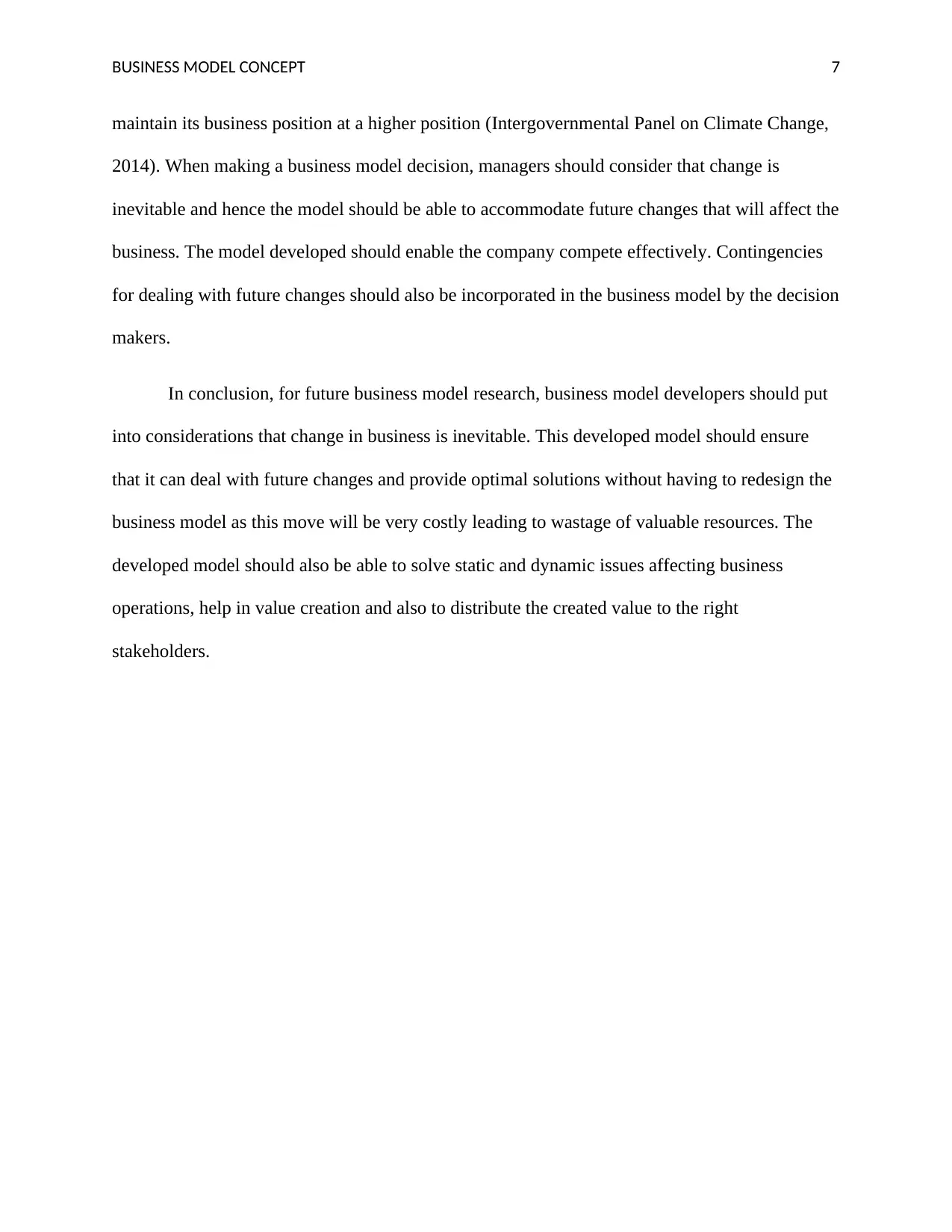
BUSINESS MODEL CONCEPT 7
maintain its business position at a higher position (Intergovernmental Panel on Climate Change,
2014). When making a business model decision, managers should consider that change is
inevitable and hence the model should be able to accommodate future changes that will affect the
business. The model developed should enable the company compete effectively. Contingencies
for dealing with future changes should also be incorporated in the business model by the decision
makers.
In conclusion, for future business model research, business model developers should put
into considerations that change in business is inevitable. This developed model should ensure
that it can deal with future changes and provide optimal solutions without having to redesign the
business model as this move will be very costly leading to wastage of valuable resources. The
developed model should also be able to solve static and dynamic issues affecting business
operations, help in value creation and also to distribute the created value to the right
stakeholders.
maintain its business position at a higher position (Intergovernmental Panel on Climate Change,
2014). When making a business model decision, managers should consider that change is
inevitable and hence the model should be able to accommodate future changes that will affect the
business. The model developed should enable the company compete effectively. Contingencies
for dealing with future changes should also be incorporated in the business model by the decision
makers.
In conclusion, for future business model research, business model developers should put
into considerations that change in business is inevitable. This developed model should ensure
that it can deal with future changes and provide optimal solutions without having to redesign the
business model as this move will be very costly leading to wastage of valuable resources. The
developed model should also be able to solve static and dynamic issues affecting business
operations, help in value creation and also to distribute the created value to the right
stakeholders.
Paraphrase This Document
Need a fresh take? Get an instant paraphrase of this document with our AI Paraphraser
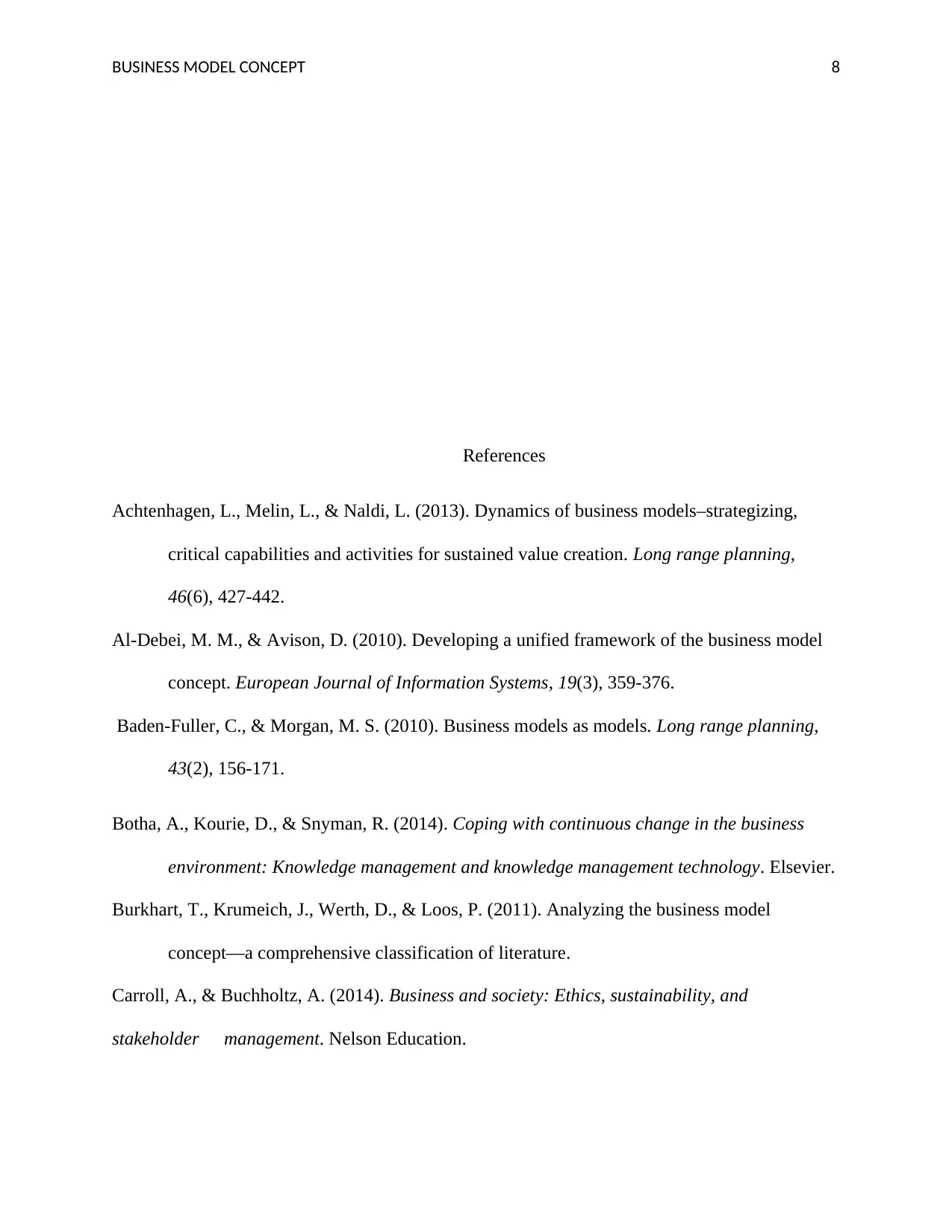
BUSINESS MODEL CONCEPT 8
References
Achtenhagen, L., Melin, L., & Naldi, L. (2013). Dynamics of business models–strategizing,
critical capabilities and activities for sustained value creation. Long range planning,
46(6), 427-442.
Al-Debei, M. M., & Avison, D. (2010). Developing a unified framework of the business model
concept. European Journal of Information Systems, 19(3), 359-376.
Baden-Fuller, C., & Morgan, M. S. (2010). Business models as models. Long range planning,
43(2), 156-171.
Botha, A., Kourie, D., & Snyman, R. (2014). Coping with continuous change in the business
environment: Knowledge management and knowledge management technology. Elsevier.
Burkhart, T., Krumeich, J., Werth, D., & Loos, P. (2011). Analyzing the business model
concept—a comprehensive classification of literature.
Carroll, A., & Buchholtz, A. (2014). Business and society: Ethics, sustainability, and
stakeholder management. Nelson Education.
References
Achtenhagen, L., Melin, L., & Naldi, L. (2013). Dynamics of business models–strategizing,
critical capabilities and activities for sustained value creation. Long range planning,
46(6), 427-442.
Al-Debei, M. M., & Avison, D. (2010). Developing a unified framework of the business model
concept. European Journal of Information Systems, 19(3), 359-376.
Baden-Fuller, C., & Morgan, M. S. (2010). Business models as models. Long range planning,
43(2), 156-171.
Botha, A., Kourie, D., & Snyman, R. (2014). Coping with continuous change in the business
environment: Knowledge management and knowledge management technology. Elsevier.
Burkhart, T., Krumeich, J., Werth, D., & Loos, P. (2011). Analyzing the business model
concept—a comprehensive classification of literature.
Carroll, A., & Buchholtz, A. (2014). Business and society: Ethics, sustainability, and
stakeholder management. Nelson Education.
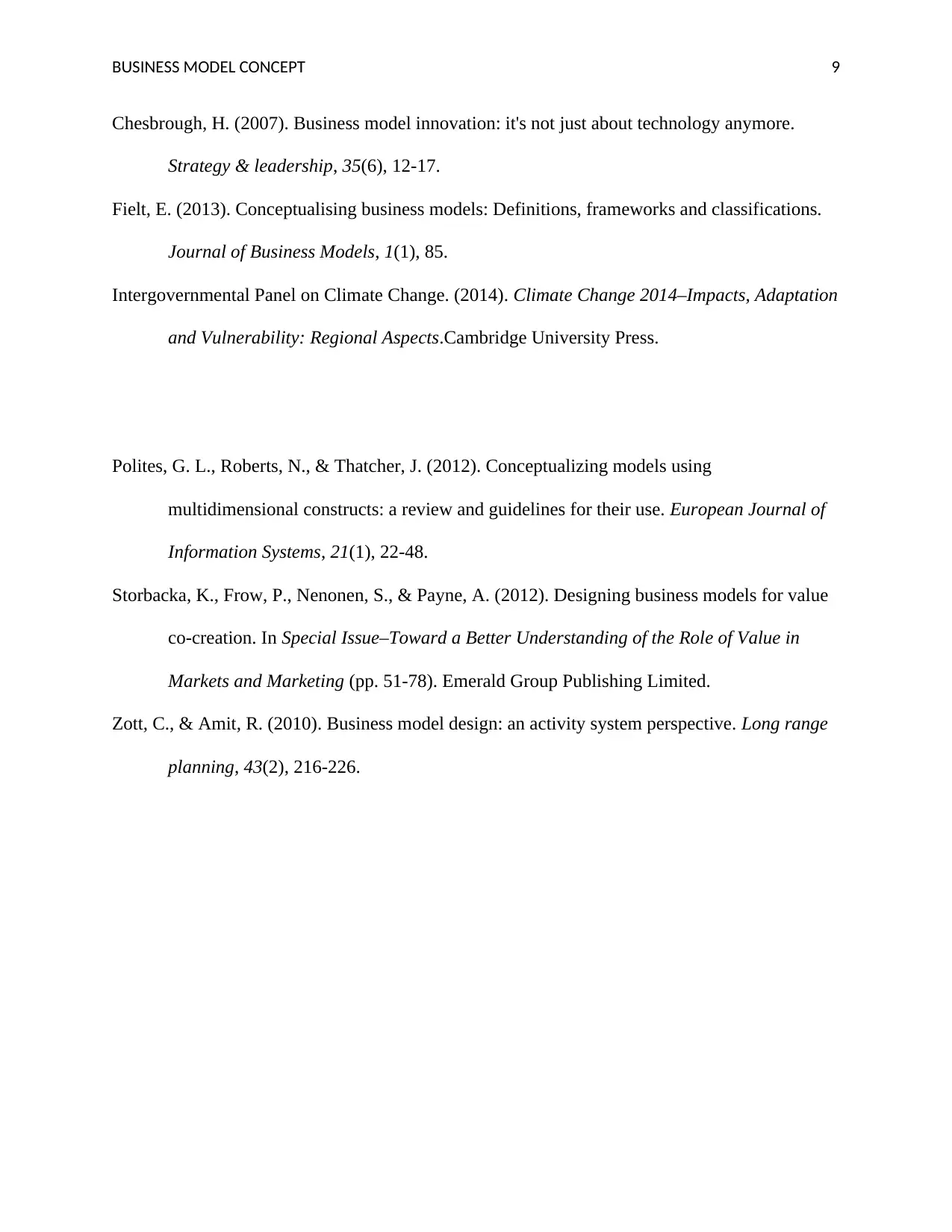
BUSINESS MODEL CONCEPT 9
Chesbrough, H. (2007). Business model innovation: it's not just about technology anymore.
Strategy & leadership, 35(6), 12-17.
Fielt, E. (2013). Conceptualising business models: Definitions, frameworks and classifications.
Journal of Business Models, 1(1), 85.
Intergovernmental Panel on Climate Change. (2014). Climate Change 2014–Impacts, Adaptation
and Vulnerability: Regional Aspects.Cambridge University Press.
Polites, G. L., Roberts, N., & Thatcher, J. (2012). Conceptualizing models using
multidimensional constructs: a review and guidelines for their use. European Journal of
Information Systems, 21(1), 22-48.
Storbacka, K., Frow, P., Nenonen, S., & Payne, A. (2012). Designing business models for value
co-creation. In Special Issue–Toward a Better Understanding of the Role of Value in
Markets and Marketing (pp. 51-78). Emerald Group Publishing Limited.
Zott, C., & Amit, R. (2010). Business model design: an activity system perspective. Long range
planning, 43(2), 216-226.
Chesbrough, H. (2007). Business model innovation: it's not just about technology anymore.
Strategy & leadership, 35(6), 12-17.
Fielt, E. (2013). Conceptualising business models: Definitions, frameworks and classifications.
Journal of Business Models, 1(1), 85.
Intergovernmental Panel on Climate Change. (2014). Climate Change 2014–Impacts, Adaptation
and Vulnerability: Regional Aspects.Cambridge University Press.
Polites, G. L., Roberts, N., & Thatcher, J. (2012). Conceptualizing models using
multidimensional constructs: a review and guidelines for their use. European Journal of
Information Systems, 21(1), 22-48.
Storbacka, K., Frow, P., Nenonen, S., & Payne, A. (2012). Designing business models for value
co-creation. In Special Issue–Toward a Better Understanding of the Role of Value in
Markets and Marketing (pp. 51-78). Emerald Group Publishing Limited.
Zott, C., & Amit, R. (2010). Business model design: an activity system perspective. Long range
planning, 43(2), 216-226.
⊘ This is a preview!⊘
Do you want full access?
Subscribe today to unlock all pages.

Trusted by 1+ million students worldwide
1 out of 9
Related Documents
Your All-in-One AI-Powered Toolkit for Academic Success.
+13062052269
info@desklib.com
Available 24*7 on WhatsApp / Email
![[object Object]](/_next/static/media/star-bottom.7253800d.svg)
Unlock your academic potential
Copyright © 2020–2025 A2Z Services. All Rights Reserved. Developed and managed by ZUCOL.





